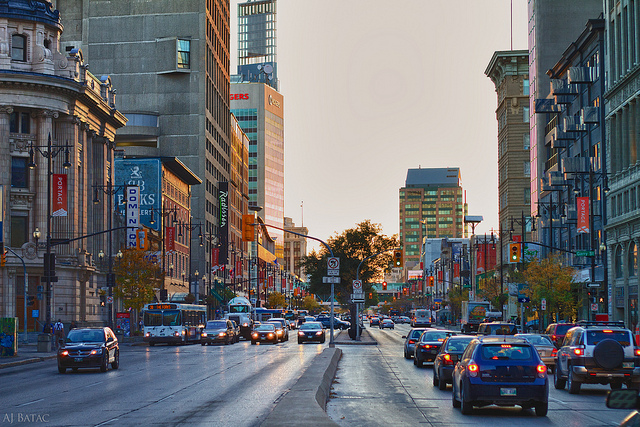Like this column? rabble is reader-supported journalism. Chip in to keep stories like these coming.
Ride-sharing service Uber wants into the Winnipeg taxi market. Looking past the marketing facade, Uber isn’t innovative or inevitable. Uber is in fact deregulation of the taxi industry, modernized using smart phone applications and an aggressive expansion campaign.
Studies of the deregulation of the taxi industry in other jurisdictions find a decline in efficiency, productivity, overall service and driver income. Taxi drivers still struggle with long hours and insufficient income. Recently Duffy’s Taxi and Unicity Taxi formed the Winnipeg Taxi Alliance to fight Uber’s potential incursion into the Winnipeg market.
Uber has advertised for drivers in Winnipeg. Currently, it is not permitted to operate under Manitoba’s Taxicab Act. A provincial review of the taxicab industry, including programs like Uber, is underway with public consultations to begin after the provincial election.
The actual numbers of what Uber drivers are paid is hard to come by, but there have been investigations. Justin Singer, writing in Valleywag (part of Gawker) finds that an Uber driver in New York City “grosses about as much in his average hour as a yellow cab grosses in his worst hour.” This is a far cry from $90,000 annual earnings touted by Uber.
Emily Guendelsberger, writer with the Philadelphia City Paper, drove as an Uber driver to try to make sense of pay and conditions. To make $90,000 annually, she found she would have to work 27 hours a day, 365 days a year. She went on to conclude that “Driving for Uber isn’t the worst-paying job I’ve ever had. I made less scooping ice cream as a 15-year-old, if you don’t adjust for inflation. If I worked 10 hours a day, six days a week with one week off, I’d net almost $30,000 a year before taxes.”
Uber claims it is not an employer, saying it simply provides contractors with customers willing to pay for a service. Uber takes this concept so far as to claim that Uber drivers are “entrepreneurs” who are working for themselves and thus beyond the control of a traditional boss. Uber says drivers are “supervised” by their customers.
The Uber app allows customers to “rate” Uber drivers on their experience. If a driver’s rating falls below a certain amount, the driver can be “de-activated”: which is Uber-speak for being fired. They lose access to the Uber app, and thus their job and any future income. There is no recourse for drivers.
Uber drivers risk losing their jobs for not following cancellation rates and acceptance rates set by the company. This means Uber, not the driver, regulates how much a driver works and what kind of fares they take, and forbids tipping drivers. By regulating work practices, discipline and dismissal, Uber is creating a precarious work environment veiled in language touting entrepreneurialism.
One of the key concerns of Uber is the inability of the service to accommodate persons with physical disabilities or mobility issues. There are several suits against Uber for discriminating against the visually impaired and wheelchair-using passengers. Uber’s position is that it’s a technology company, not a transport company, so it does not have to abide by laws that would set how they would have to accommodate these passengers. In one case from California, an Uber driver locked a women’s guide dog in the trunk.
Uber has launched services that would accommodate both the seeing impaired and wheelchair users. Many activists point out that providing these separate services does not solve the problem, as Uber is legally required to provide services to both groups in its main fleet like other transport services.
Uber perpetuates car culture in cities, exacerbating greenhouse gas emissions and pollution. Brian Fung in the Washington Post explains that Uber’s success in a particular city is directly proportional to how much infrastructure is geared towards cars. Cities that have fewer transportation options, less walkability, and greater car-dependency tend to take to Uber because the transportation culture and publicly funded road system are already there for Uber.
It is no secret that Winnipeg has a strong car culture. The majority of the infrastructure is not built to accommodate safe and convenient cyclist or pedestrian traffic. Winnipeg Transit has the lowest number of buses per capita of cities a similar size, and delays with rapid transit development mean long travel times by bus.
Uber puts more cars on the road for those who can afford to take this service. Simply shifting the burden of the driving does not change Winnipeg’s transport problems and exacerbates car dependency.
The solution is better public transit, infrastructure that promotes walking and cycling and less car dependent cities over all. Transport and taxi workers deserve good jobs with benefits and safe working conditions. Uber is simply not the answer to the transit problems facing Winnipeg and cities across North America.
This article has been edited to clarify the legal status of Uber and other ridesharing corporations in the province of Manitoba.
Scott Price is an organizer and researcher in Winnipeg.
Photo: AJ Batac/flickr
Like this column? rabble is reader-supported journalism. Chip in to keep stories like these coming.



